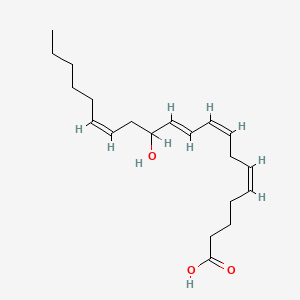
|
12-HETE |
12-HETE is a lipid of Fatty Acyls (FA) class. 12-HETE is associated with abnormalities such as Endothelial dysfunction, Stable angina, Diabetes and Ischemia. The involved functions are known as Inflammation, Protective Agents, Exocytosis, inhibitors and Signal Transduction. 12-HETE often locates in Endothelium, Integumentary system, Articular system, Tissue fiber and Knee. The related lipids are 9-hydroxy-10,12-octadecadienoic acid, 13-hydroperoxy-9,11-octadecadienoic acid, hydroxy fatty acid and DOPE. |
1073 |
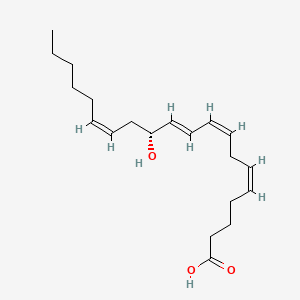
|
12(r)-hete |
12(r)-hete is a lipid of Fatty Acyls (FA) class. |
1079 |
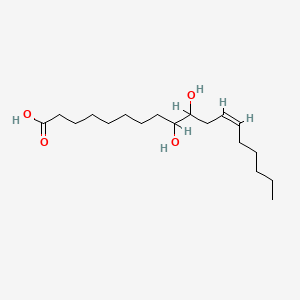
|
9,10-DiHOME |
9,10-dihome is a lipid of Fatty Acyls (FA) class. |
1159 |
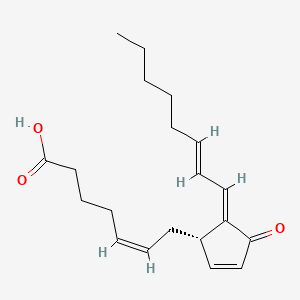
|
15-deoxy-delta-12,14-PGJ2 |
15-deoxy-delta-12,14-pgj2 is a lipid of Fatty Acyls (FA) class. 15-deoxy-delta-12,14-pgj2 is associated with abnormalities such as Dehydration and Myocardial Ischemia. The involved functions are known as Binding (Molecular Function), Inflammation, Alveolar ventilation function, Stimulus and Process. 15-deoxy-delta-12,14-pgj2 often locates in Cytosol, Myocardial tissue and Heart tissue. The associated genes with 15-deoxy-delta-12,14-PGJ2 are Homologous Gene and G-substrate. The related lipids are 15-deoxyprostaglandin J2 and Lipopolysaccharides. |
1201 |

|
(-)-Epigallocatechin |
(-)-Epigallocatechin is a lipid of Polyketides (PK) class. The involved functions are known as Protective Agents, inhibitors, Process, Drug Kinetics and Fermentation. (-)-epigallocatechin often locates in Hepatic, Blood, Membrane, Back and apical membrane. The associated genes with (-)-Epigallocatechin are ADRBK1 gene and FASTK Gene. The related lipids are 1,2-dilinolenoyl-3-(4-aminobutyryl)propane-1,2,3-triol. The related experimental models are Rodent Model and Transgenic Model. |
1282 |

|
SCHEMBL105486 |
Kakonein is a lipid of Polyketides (PK) class. Kakonein is associated with abnormalities such as Fatty Liver, Chronic liver disease, Morphologically altered structure, Hypertensive disease and Cardiovascular Diseases. The involved functions are known as protein expression, Extravasation, Liver damage, mRNA Expression and cell activation. Kakonein often locates in Body tissue, Hepatic, Microvilli, Cytoplasm and Membrane. The associated genes with Kakonein are TJP1 gene, CD14 gene, iberiotoxin, AT-Rich Interactive Domain-Containing Protein 1A and NKS1 gene. The related lipids are dehydrosoyasaponin I and Steroids. The related experimental models are Knock-out. |
1391 |
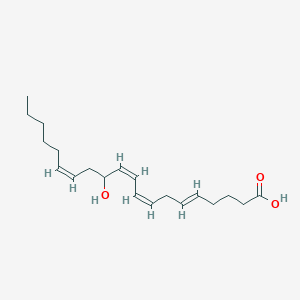
|
12-hete |
12-hete is a lipid of Fatty Acyls (FA) class. |
1452 |
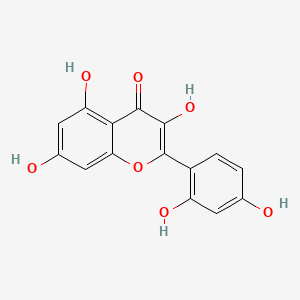
|
morin |
morin is a lipid of Polyketides (PK) class. Morin is associated with abnormalities such as Colitis, Hyperuricemia, Gout, Parkinson Disease and Rheumatoid Arthritis. The involved functions are known as establishment and maintenance of localization, Binding (Molecular Function), Uptake, Increased Sensitivy and Cell Cycle Arrest. Morin often locates in Cell Wall, apoplast, Plasma membrane, Cytoplasmic matrix and Membrane. The associated genes with morin are GADD45A gene, MAPK8 gene, ODAM gene, TNFRSF1A gene and ALPP gene. The related lipids are Lipopolysaccharides, Butyrates, Fatty Acids, Nonesterified, Palmitates and Oleates. |
1499 |

|
emodin |
emodin is a lipid of Polyketides (PK) class. Emodin is associated with abnormalities such as Infection, Conjunctivitis, Vernal, Stevens-Johnson Syndrome, Conjunctival scar and Allergic Conjunctivitis. The involved functions are known as signaling cascade, Metabolic Inhibition, Cell Death, Phosphorylation and JNK Pathway. Emodin often locates in Membrane, Protoplasm, Mitochondria, Cytoplasmic matrix and soluble. The associated genes with emodin are cytochrome c'', UTS2 gene, TK Gene, Gene Clusters and CFC1 gene. The related lipids are Phosphatidylserines, Promega, Sphingolipids, Membrane Lipids and Palmitates. The related experimental models are Mouse Model and Transgenic Model. |
1742 |
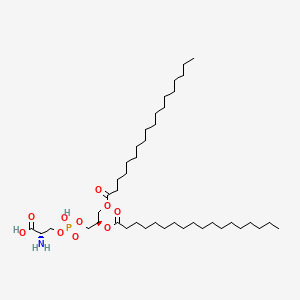
|
51446-62-9 |
51446-62-9 is a lipid of Glycerophospholipids (GP) class. 51446-62-9 is associated with abnormalities such as Virus Diseases, Infection, Bacterial Infections, Communicable Diseases and Exanthema. The involved functions are known as Phagocytosis, Obstruction, Binding (Molecular Function), targeting and inhibitors. 51446-62-9 often locates in Head, Clone, Cell membrane, Cell surface and host. The associated genes with 51446-62-9 are Homologous Gene, Orthologous Gene, Fusion Protein, ETV3 gene and Amino Acids, Basic. The related lipids are Phosphatidylserines, Lipopolysaccharides, 1-palmitoyl-2-oleoylphosphatidylethanolamine, beta-amyrin and Membrane Lipids. |
1744 |
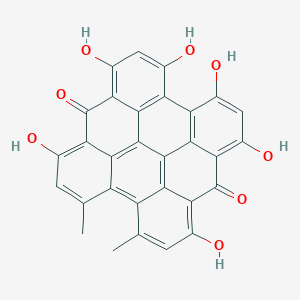
|
hypericin |
hypericin is a lipid of Polyketides (PK) class. Hypericin is associated with abnormalities such as Dermatitis, Phototoxic, Dehydration, Photosensitization, Morphologically altered structure and Myocardial Infarction. The involved functions are known as Cell Cycle Checkpoints, Apoptosis, Acetylation, Cell Survival and Caspase Activation. Hypericin often locates in insoluble fraction, Cytoplasmic matrix, Protoplasm, Tissue membrane and Cytoplasm. The associated genes with hypericin are CDC37 gene, HSPA8 gene, RAF1 gene, cyclin H and FK228. The related lipids are Phosphatidylserines. |
1752 |

|
(e,e,e,e)-squalene |
(e,e,e,e)-squalene is a lipid of Fatty Acyls (FA) class. (e,e,e,e)-squalene is associated with abnormalities such as Hypercholesterolemia and Cataract. The involved functions are known as Process, metaplastic cell transformation, Protein Overexpression, Anabolism and Biosynthetic Pathways. (e,e,e,e)-squalene often locates in Membrane, Protoplasm, Plasma membrane, Tissue membrane and Back. The associated genes with (e,e,e,e)-squalene are Genome, IMPACT gene, GAPDH gene, GTF2I gene and Chromatin. The related lipids are Membrane Lipids, cycloartenol, Sterols, Fatty Acids and Nonesterified Fatty Acids. |
1766 |
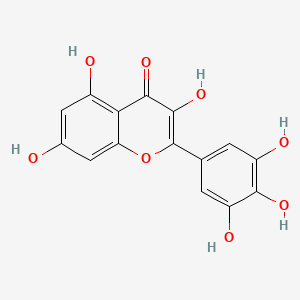
|
myricetin |
myricetin is a lipid of Polyketides (PK) class. Myricetin is associated with abnormalities such as Diabetes, First myocardial infarction, Diabetes Mellitus, Non-Insulin-Dependent, Asthma and Cataract. The involved functions are known as Cell Survival, inhibitors, Process, Metabolic Inhibition and Oxidation. Myricetin often locates in Fibril - cell component, soluble, Body tissue, Back and Tissue membrane. The associated genes with myricetin are HPGDS gene, P4HTM gene, CFLAR gene, SLC2A2 gene and SLC2A1 gene. The related lipids are Promega, Sterols, dipalmitoylphosphatidylserine, 1,2-oleoylphosphatidylcholine and Membrane Lipids. |
1801 |
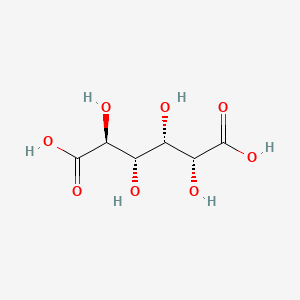
|
Glucaric acid |
Glucaric acid is a lipid of Fatty Acyls (FA) class. Glucaric acid is associated with abnormalities such as Consumption-archaic term for TB and furuncle. The involved functions are known as Oxidation, Mutation, Process, Cell Growth and Anabolism. Glucaric acid often locates in BL21, Clone and host. The associated genes with Glucaric acid are MIOX gene, ISYNA1 gene, Genome and Candidate Disease Gene. The related experimental models are Knock-out. |
1814 |
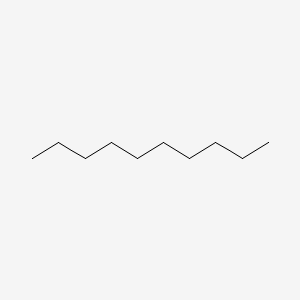
|
Decane |
Decane is a lipid of Fatty Acyls (FA) class. |
1934 |

|
baicalein |
baicalein is a lipid of Polyketides (PK) class. Baicalein is associated with abnormalities such as Neurodegenerative Disorders, Fibrillation, Hypertensive disease, Aortic coarctation and Coronary Occlusion. The involved functions are known as Anabolism, Polymerization, Process, inhibitors and Pathogenesis. Baicalein often locates in Membrane, Lipid Bilayers, soluble, Cell-Free System and Protoplasm. The associated genes with baicalein are P4HTM gene, BIRC5 gene, TSPO gene, SHOC2 gene and XIAP gene. The related lipids are Fatty Acids, Nonesterified Fatty Acids, iodoresiniferatoxin, Lipopolysaccharides and 17-octadecynoic acid. The related experimental models are Knock-out, Mouse Model and Parkinsonism, Experimental. |
1997 |

|
Sphingosine 1-phosphate |
Sphingosine 1-phosphate is a lipid of Sphingolipids (SP) class. Sphingosine 1-phosphate is associated with abnormalities such as Infection, Painful Bladder Syndrome, Atherosclerosis, Hyperglycemia and Rheumatoid Arthritis. The involved functions are known as Phosphorylation, Regulation, enzyme activity, Energy Absorption and Vascular Permeability. Sphingosine 1-phosphate often locates in Endothelium, Tissue membrane, Vascular System, Protoplasm and Microfilaments. The associated genes with Sphingosine 1-phosphate are MBTPS1 gene, FBXL15 gene, TEK gene, NTRK1 gene and Gene Family. The related lipids are Promega, Lipopolysaccharides, lysophosphatidic acid, Lysophosphatidylcholines and Lysophospholipids. The related experimental models are Knock-out, Mouse Model, Transgenic Model, Disease model and Experimental Autoimmune Encephalomyelitis. |
2005 |

|
Nystatin A3 |
Nystatin A3 is a lipid of Polyketides (PK) class. Nystatin a3 is associated with abnormalities such as Mycoses, Candidiasis of the genitals and Gigantism. The involved functions are known as Drug Interactions, Process, Synthesis, Fermentation and Anabolism. Nystatin a3 often locates in Cell membrane, Membrane, Protoplasm, Entire oral cavity and integral to membrane. The associated genes with Nystatin A3 are Gene Clusters. The related lipids are Sterols, 1,2-oleoylphosphatidylcholine, Membrane Lipids, DOPE and N-caproylsphingosine. |
2059 |
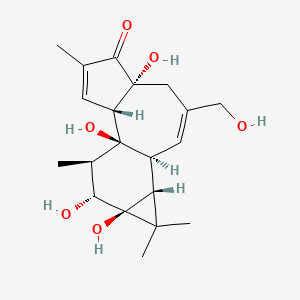
|
Phorbol |
Phorbol is a lipid of Prenol Lipids (PR) class. Phorbol is associated with abnormalities such as furuncle, Infection, endothelial dysfunction, Morphologically altered structure and Acute erythroleukemia. The involved functions are known as Tyrosine Phosphorylation, Metabolic Inhibition, Transcription, Genetic, Protein Biosynthesis and Signal. Phorbol often locates in Tissue membrane, Membrane, Cell surface, soluble and Cytoplasmic Domain. The associated genes with Phorbol are STAT3 gene, JAK2 gene, JUN gene, PROC gene and MAPK8 gene. The related lipids are Lipopolysaccharides, Phosphatidylserines, Liposomes, Fatty Acids and Octanols. |
2082 |

|
FLAVONE |
FLAVONE is a lipid of Polyketides (PK) class. Flavone is associated with abnormalities such as Cardiovascular Diseases, Cerebrovascular accident, DERMATITIS HERPETIFORMIS, FAMILIAL, Hyperinsulinism and Inflammatory disorder. The involved functions are known as Oxidation-Reduction, Metabolic Inhibition, Inflammation, Phosphorylation and antioxidant activity. Flavone often locates in Endothelium, Hepatic, Protoplasm, Body tissue and Extracellular. The associated genes with FLAVONE are ICAM1 gene, BCL2L1 gene, MYC gene, TP53 gene and cytochrome c''. The related lipids are Promega, Steroids and Total cholesterol. The related experimental models are Knock-out, Disease model and Animal Disease Models. |
2093 |
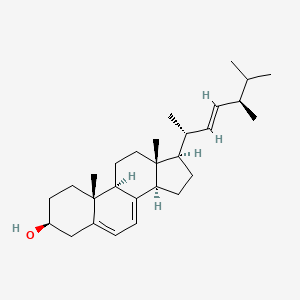
|
Ergosterol |
Ergosterol is a lipid of Sterol Lipids (ST) class. Ergosterol is associated with abnormalities such as Disintegration (morphologic abnormality), Consumption-archaic term for TB, Candidiasis, Mycoses and Iodotyrosyl coupling defect. The involved functions are known as Anabolism, sporulation, 5-(carboxyamino)imidazole ribonucleotide mutase activity, Subtraction process and Physiologic Organization. Ergosterol often locates in Pore, Membrane, Protoplasm, Plasma membrane and Endoplasmic Reticulum. The associated genes with Ergosterol are IMPACT gene, BLVRB gene, CYP51A1 gene, CDR1 wt Allele and HM13 gene. The related lipids are Sterols, Cardiolipins, Membrane Lipids, fecosterol and Phosphatidylserines. The related experimental models are Knock-out. |
2200 |
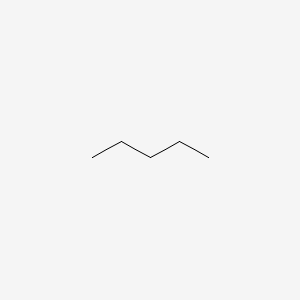
|
Pentane |
Pentane is a lipid of Fatty Acyls (FA) class. |
2265 |
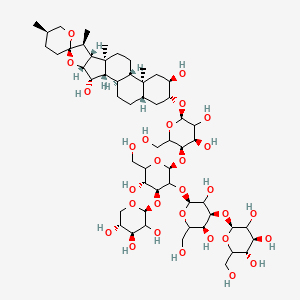
|
Digitonin |
Digitonin is a lipid of Sterol Lipids (ST) class. Digitonin is associated with abnormalities such as SCHOPF-SCHULZ-PASSARGE SYNDROME (disorder), Infection, BOSLEY-SALIH-ALORAINY SYNDROME, Hyperostosis, Diffuse Idiopathic Skeletal and FRONTOTEMPORAL DEMENTIA, CHROMOSOME 3-LINKED. The involved functions are known as Coprecipitation, establishment and maintenance of localization, Mutation, protein thiol-disulfide exchange and Receptor Binding. Digitonin often locates in Protoplasm, Cytoplasm, Membrane, Cytoplasmic matrix and Cytoplasmic Domain. The associated genes with Digitonin are Integral Membrane Proteins, Polypeptides, GOLPH3 gene, GAS1 gene and TRAF3IP2 gene. The related lipids are Promega, Sterols, 1,2-dihexadecyl-sn-glycero-3-phosphocholine, proteoliposomes and Lysophosphatidylcholines. |
2282 |
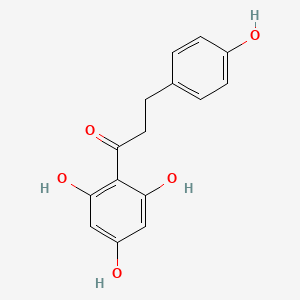
|
phloretin |
phloretin is a lipid of Polyketides (PK) class. Phloretin is associated with abnormalities such as Atherosclerosis, Diabetes Mellitus, Non-Insulin-Dependent, Alkalemia, Renal tubular disorder and pathologic fistula. The involved functions are known as Anabolism, glycosyltransferase activity, Biosynthetic Pathways, Localized desquamation and Biological Processes. Phloretin often locates in soluble, BL21, Cytoplasmic, Extracellular and Cytoplasm. The associated genes with phloretin are Homologous Gene, CD36 gene, Candidate Disease Gene, SLC33A1 gene and PAK1IP1 gene. The related lipids are Liposomes, Palmitates, Fatty Acids, Sterols and 6-ketocholestanol. The related experimental models are Knock-out. |
2367 |

|
Gossypol |
Gossypol is a lipid of Prenol Lipids (PR) class. Gossypol is associated with abnormalities such as Paralytic Ileus, PARKINSON DISEASE, LATE-ONSET, Fibrillation, Hepatic necrosis and Lymphopenia. The involved functions are known as Atrophic, Ulcer, Necrosis, Apoptosis and antagonists. Gossypol often locates in Mucous Membrane, Epithelium, Blood, Microsomes, Liver and Autophagic vacuole. The associated genes with Gossypol are BCL2A1 gene, BCL2 gene, Transgenes, IGH@ gene cluster and Bax protein (53-86). The related lipids are Promega, proteoliposomes, Phosphatidylserines and Liposomes. The related experimental models are Transgenic Model and Xenograft Model. |
2557 |

|
ZEARALENONE |
ZEARALENONE is a lipid of Polyketides (PK) class. Zearalenone is associated with abnormalities such as HYPOTRICHOSIS, LOCALIZED, AUTOSOMAL RECESSIVE, 2, Estrogen excess, Food-Drug Interactions, Osteomalacia and Osteoporosis. The involved functions are known as mRNA Expression, Metabolic Inhibition, Phosphorylation, Agent and Transcriptional Activation. Zearalenone often locates in Gastrointestinal tract structure, soluble, viral nucleocapsid location, Spindle and Hepatic. The associated genes with ZEARALENONE are Candidate Disease Gene, Genome, Genes, Reporter, P4HTM gene and Open Reading Frames. The related lipids are Lipopolysaccharides, Steroids, Fatty Acids and Promega. The related experimental models are Transgenic Model. |
2573 |
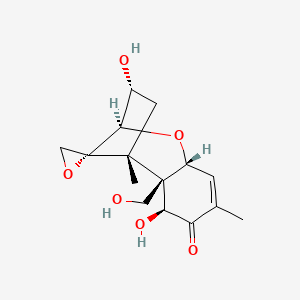
|
Vomitoxin |
Vomitoxin is a lipid of Prenol Lipids (PR) class. Vomitoxin is associated with abnormalities such as Infection and Gastroenteritis. The involved functions are known as mRNA Expression, Inflammation, Transcription, Genetic, Protein Biosynthesis and Adverse effects. Vomitoxin often locates in Lymphoid Tissue, Immune system, Bone Marrow and Plasma membrane. The associated genes with Vomitoxin are IMPACT gene, HIST1H1C gene and RBM39 gene. The related experimental models are Mouse Model. |
2643 |
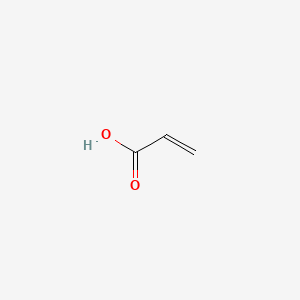
|
Acrylic acid |
Acrylic acid is a lipid of Fatty Acyls (FA) class. Acrylic acid is associated with abnormalities such as Wiskott-Aldrich Syndrome. The involved functions are known as Diastasis, Oxidation, Metabolic Inhibition, Fermentation and Anabolism. Acrylic acid often locates in Back, Blood, Entire bony skeleton and Transplanted tissue. The associated genes with Acrylic acid are GJA1 gene and FADD gene. The related lipids are Fatty Acids, Decanoates and Fatty Acids, Nonesterified. |
2898 |
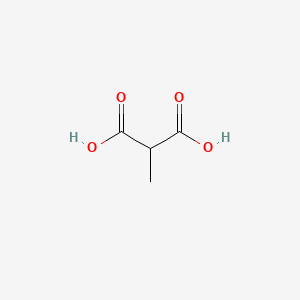
|
Methylmalonic acid |
Methylmalonic acid is a lipid of Fatty Acyls (FA) class. Methylmalonic acid is associated with abnormalities such as Vitamin B 12 Deficiency, Osteoporosis, Anemia, Anemia, Megaloblastic and Renal impairment. The involved functions are known as Abnormal renal function, Lactation, physiological aspects, phosphoglycerate dehydrogenase activity and Excretory function. Methylmalonic acid often locates in Entire bony skeleton, Blood, Protoplasm, Muscle and Body tissue. The associated genes with Methylmalonic acid are IMPACT gene, ACSF3 gene, CBLC gene, MMADHC gene and LMBRD1 gene. The related lipids are Fatty Acids and Butanols. |
3174 |

|
luteolin |
luteolin is a lipid of Polyketides (PK) class. Luteolin is associated with abnormalities such as Morphologically altered structure, Nodule, retinal toxicity, CLEFT LIP, CONGENITAL HEALED and Ischemia. The involved functions are known as Metabolic Inhibition, Cell Death, Caspase Activation, activation of protein kinase C activity by G-protein coupled receptor protein signaling pathway and protein kinase C activity. Luteolin often locates in Mitochondria, Cell-Free System, Protoplasm, Membrane and Body tissue. The associated genes with luteolin are BCL2 gene, TNFSF10 gene, BCL2L1 gene, XIAP gene and MCL1 gene. The related lipids are Lipopolysaccharides, Sterols, blood lipid, Fatty Acids and Steroids. The related experimental models are Xenograft Model, Mouse Model, Experimental Autoimmune Encephalomyelitis, Knock-out and Cancer Model. |
3284 |
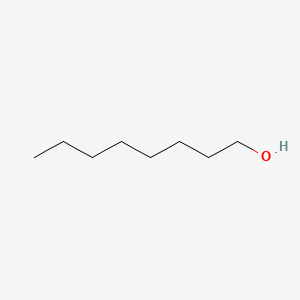
|
n-octanol |
N-octanol is a lipid of Fatty Acyls (FA) class. N-octanol is associated with abnormalities such as Wiskott-Aldrich Syndrome. The involved functions are known as Mutation and Detergents. N-octanol often locates in Tissue membrane. The related lipids are Octanols and 1-Octanol. |
3305 |
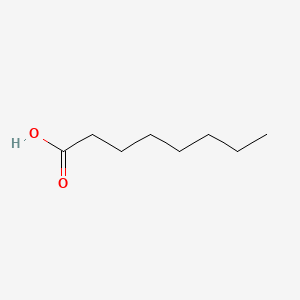
|
octanoic acid |
octanoic acid is a lipid of Fatty Acyls (FA) class. Octanoic acid is associated with abnormalities such as Ischemia, Diabetes Mellitus, Non-Insulin-Dependent, Diabetes, Cardiomyopathies and Obesity. The involved functions are known as Anabolism, 5-(carboxyamino)imidazole ribonucleotide mutase activity, Citric Acid Cycle, Metabolic Inhibition and Excretory function. Octanoic acid often locates in Pore, Protoplasm, Endothelium, Mitochondria and Muscle. The associated genes with octanoic acid are P4HTM gene, CPT1A gene, HADH gene, ACSL1 Gene and CD36 gene. The related lipids are Fatty Acids, Nonesterified Fatty Acids, Oleates, Palmitates and hexanoic acid. |
3349 |
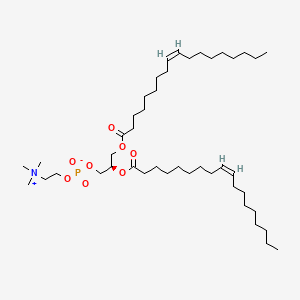
|
1,2-Dioleoyl-sn-Glycero-3-Phosphocholine |
1,2-Dioleoyl-sn-Glycero-3-Phosphocholine is a lipid of Glycerophospholipids (GP) class. 1,2-dioleoyl-sn-glycero-3-phosphocholine is associated with abnormalities such as Exanthema, Renal tubular disorder, Nodule, Gigantism and Mycoses. The involved functions are known as Lysis, Encapsulation, Process, Uptake and Flow or discharge. 1,2-dioleoyl-sn-glycero-3-phosphocholine often locates in Cytoplasmic matrix, Endosomes, soluble, Endoplasmic Reticulum and Membrane. The associated genes with 1,2-Dioleoyl-sn-Glycero-3-Phosphocholine are P4HTM gene, synthetic peptide, BCAR1 gene, PCNA gene and CNTNAP1 gene. The related lipids are Liposomes, 1,2-oleoylphosphatidylcholine, 1,2-distearoylphosphatidylethanolamine, Butanols and Cardiolipins. The related experimental models are Mouse Model and Xenograft Model. |
3428 |
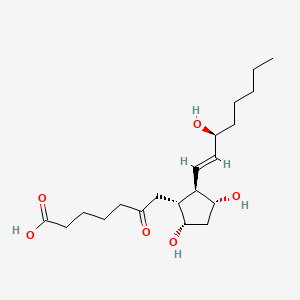
|
6-keto-pgf1alpha |
6-keto-pgf1alpha is a lipid of Fatty Acyls (FA) class. |
3430 |

|
1-Oleoyl Lysophosphatidic Acid |
1-Oleoyl Lysophosphatidic Acid is a lipid of Glycerophospholipids (GP) class. 1-oleoyl lysophosphatidic acid is associated with abnormalities such as Myocardial Infarction, early pregnancy, Scleroderma, Blind Vision and Hyperlipidemia. The involved functions are known as Agent, Blood coagulation, Selection, Genetic, Analyte and Biological Processes. 1-oleoyl lysophosphatidic acid often locates in Tissue specimen, Body tissue, Blood, Membrane and Skin. The associated genes with 1-Oleoyl Lysophosphatidic Acid are Mucin-16, Peptides, SMAD4 gene, RND1 gene and Polypeptides. The related lipids are lysophosphatidic acid, A(2)C, Lysophospholipids, Fatty Acids and sphingosine 1-phosphate. The related experimental models are Mouse Model, Knock-out, Cancer Model, Xenograft Model and Arthritis, Adjuvant-Induced. |
3463 |
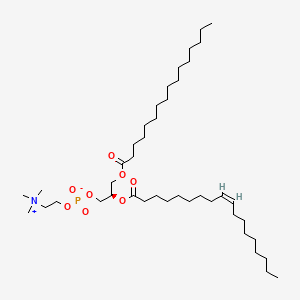
|
POPC |
POPC is a lipid of Glycerophospholipids (GP) class. Popc is associated with abnormalities such as Hyperlipidemia, Atherosclerosis, Type I Mucolipidosis, Coronary Arteriosclerosis and Coronary Artery Disease. The involved functions are known as phosphoglycerate dehydrogenase activity, Denaturation, immunoreactivity, high-density lipoprotein particle remodeling and Process. Popc often locates in high-density lipoprotein particle, viral nucleocapsid location, Plasma membrane, spherical high-density lipoprotein particle and Face. The associated genes with POPC are Mutant Proteins, SCARB1 gene, SPEN gene, Polypeptides and globular protein. The related lipids are Total cholesterol, i-cholesterol, Fatty Acids, cholesteryl oleate and Cholesterol/Phospholipid. The related experimental models are Genetically Engineered Mouse. |
3550 |
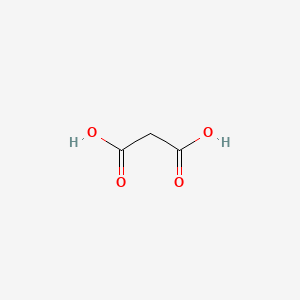
|
Malonic acid |
Malonic acid is a lipid of Fatty Acyls (FA) class. Malonic acid is associated with abnormalities such as Malonic aciduria. The involved functions are known as Vmax, Regulation, Biochemical Pathway, Citric Acid Cycle and intermediary metabolism. Malonic acid often locates in Body tissue, Mitochondria, soluble and NADH dehydrogenase complex. The associated genes with Malonic acid are ACACA gene, ACSF3 gene, Recombinant Proteins, NKS1 gene and Homologous Gene. The related lipids are Fatty Acids and Butyric Acid. |
3587 |
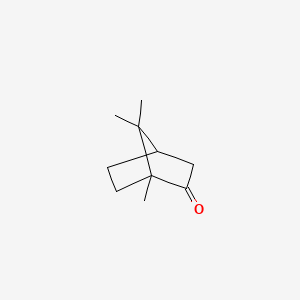
|
(+)-Camphor |
(+)-camphor is a lipid of Prenol Lipids (PR) class. (+)-camphor is associated with abnormalities such as Athetoid cerebral palsy. The involved functions are known as inhibitors, Synthesis, Feedback and Competitive inhibition. The associated genes with (+)-Camphor are 4S-limonene synthase. The related lipids are palmitoleic acid, pentadecanoic acid, stearic acid and erucic acid. |
3660 |

|
6-aminohexanoic acid |
6-aminohexanoic acid is a lipid of Fatty Acyls (FA) class. 6-aminohexanoic acid is associated with abnormalities such as Blood Clot, Myocardial Infarction, Cerebrovascular accident, Renal impairment and Scoliosis, unspecified. The involved functions are known as Fibrinolysis, Agent, Hemorrhage, plasminogen activation and inhibitors. 6-aminohexanoic acid often locates in Chest, Blood, Body tissue, peritoneal and Plasma membrane. The associated genes with 6-aminohexanoic acid are P4HTM gene, BSND gene, MTPN gene, NDUFS4 gene and Homologous Gene. The related lipids are Phosphatidylserines and Butyric Acid. |
3685 |
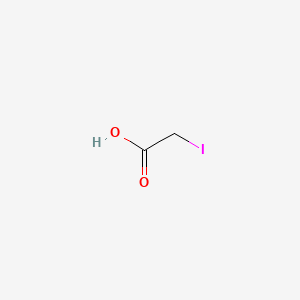
|
Iodoacetic acid |
Iodoacetic acid is a lipid of Fatty Acyls (FA) class. Iodoacetic acid is associated with abnormalities such as Photoreceptor degeneration and Post MI. The involved functions are known as Hypoxia, Glycolysis, Metabolic Inhibition, Oxidation and PTPS activity. Iodoacetic acid often locates in Extracellular, Muscle, Mitochondria, Cytoplasmic matrix and Tissue membrane. The associated genes with Iodoacetic acid are SLC33A1 gene, GTF2I gene, Mutant Proteins, TRIM33 gene and oxytocin, 1-desamino-(O-Et-Tyr)(2)-. |
3688 |
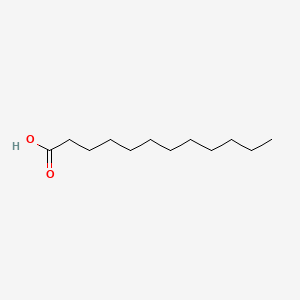
|
lauric acid |
lauric acid is a lipid of Fatty Acyls (FA) class. Lauric acid is associated with abnormalities such as Infection, Renal tubular disorder, Hypertensive disease, Obesity and Mycoses. The involved functions are known as Transcription, Genetic, Signal Transduction, Mutation, metaplastic cell transformation and Anabolism. Lauric acid often locates in Skin, Plasma membrane, Cytoplasmic matrix, Body tissue and Palmar surface. The associated genes with lauric acid are Gene Family, SLC33A1 gene, Homologous Gene, Open Reading Frames and P4HTM gene. The related lipids are Fatty Acids, Oleic Acids, Palmitates, Stearates and 9,11-linoleic acid. |
3691 |
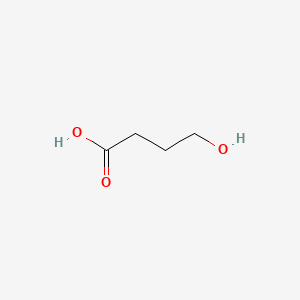
|
4-hydroxy-butyric acid |
4-hydroxy-butyric acid is a lipid of Fatty Acyls (FA) class. |
3927 |

|
alpha-linolenic acid |
Alpha-linolenic acid is a lipid of Fatty Acyls (FA) class. Alpha-linolenic acid is associated with abnormalities such as Coronary heart disease, abnormal fragmented structure, Arterial thrombosis and Subarachnoid Hemorrhage. The involved functions are known as Anabolism, Signal, Transcription, Genetic, Saturated and Regulation. Alpha-linolenic acid often locates in Blood, Body tissue, Plasma membrane, Hepatic and peroxisome. The associated genes with alpha-linolenic acid are FATE1 gene, volicitin, CYP2U1 gene, CYP1A2 gene and CYP2J2 gene. The related lipids are Fatty Acids, Dietary Fatty Acid, stearidonic acid and Fatty Acids, Nonesterified. |
4231 |

|
apigenin |
apigenin is a lipid of Polyketides (PK) class. Apigenin is associated with abnormalities such as Morphologically altered structure, Chimera disorder, Hypertensive disease, infection induced and Infection. The involved functions are known as inhibitors, Gene Expression, Process, Metabolic Inhibition and Cell Death. Apigenin often locates in Vacuole, Cytoplasmic matrix, Cytoplasm, Tissue membrane and Membrane. The associated genes with apigenin are MSMP gene, BCL2 gene, PTGS2 gene, Chromatin and SLC33A1 gene. The related lipids are Lipopolysaccharides, Steroids, 1-Butanol, agosterol A and Butyrates. The related experimental models are Mouse Model, Tissue Model, Knock-out, Xenograft Model and Disease model. |
4250 |
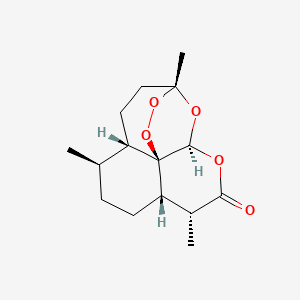
|
Artemisin |
Artemisin is a lipid of Prenol Lipids (PR) class. Artemisin is associated with abnormalities such as Malaria, Falciparum. The involved functions are known as Pressure- physical agent and secondary metabolic process. |
4738 |

|
nystatin |
nystatin is a lipid of Polyketides (PK) class. Nystatin is associated with abnormalities such as Virus Diseases, Infection, Candidiasis, Leukopenia and Mycoses. The involved functions are known as Membrane Potentials, Uptake, Flow or discharge, Cell membrane potential and adenine transport. Nystatin often locates in Cell Wall, Plasma membrane, Extracellular, Membrane and Virion. The associated genes with nystatin are Genome, Integral Membrane Proteins, Amino Acids, Basic, P4HTM gene and Homologous Gene. The related lipids are Sterols, Liposomes, Membrane Lipids, Sphingolipids and 1,2-oleoylphosphatidylcholine. The related experimental models are Knock-out and Xenograft Model. |
4890 |
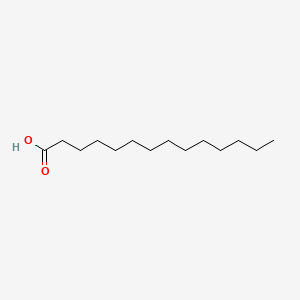
|
Tetradecanoic acid |
Tetradecanoic acid is a lipid of Fatty Acyls (FA) class. Tetradecanoic acid is associated with abnormalities such as Chronic lung disease, Infection, Spastic syndrome, Diabetes and Cardiovascular Diseases. The involved functions are known as Fatty acid biosynthetic process, Anabolism, lung alveolus development, 5-(carboxyamino)imidazole ribonucleotide mutase activity and Homeostasis. Tetradecanoic acid often locates in Structure of parenchyma of lung, Blood, Head, Membrane and Cytoplasmic matrix. The associated genes with Tetradecanoic acid are SLC33A1 gene, SFTPA1 gene, P4HTM gene, Polypeptides and GPR132 gene. The related lipids are Fatty Acids, Nonesterified Fatty Acids, palmitoleic acid, Phosphatidylglycerols and Butanols. |
5058 |
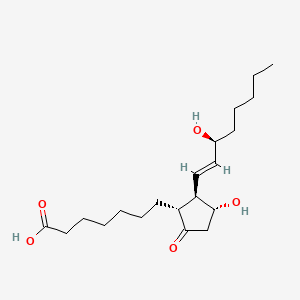
|
Prostaglandin e1 |
Prostaglandin e1 is a lipid of Fatty Acyls (FA) class. The involved functions are known as Protein Expression and Down-Regulation. |
5126 |

|
quercetin |
quercetin is a lipid of Polyketides (PK) class. Quercetin is associated with abnormalities such as Coronary heart disease, Myocardial Infarction, Cirrhosis, Coronary Arteriosclerosis and Vascular ring. The involved functions are known as Vasodilation, physiological aspects, Fermentation, Process and Ingredient. Quercetin often locates in Arterial system, Endothelium, Skin, Endothelium, Vascular and Tissue specimen. The associated genes with quercetin are P4HTM gene, SULT gene, UGT1A1 gene, ARHGAP26 gene and PLXNB1 gene. The related lipids are blood lipid, Promega, Steroids, Phosphatidylserines and Fatty Acids. The related experimental models are Knock-out, Mouse Model, Xenograft Model, Tissue Model and Cancer Model. |
5377 |

|
4-hydroxynonenal |
4-hydroxynonenal is a lipid of Fatty Acyls (FA) class. 4-hydroxynonenal is associated with abnormalities such as Chronic disease, Obesity, Diabetes, Acquired Immunodeficiency Syndrome and Lung diseases. The involved functions are known as protein expression, Glycolysis, mRNA Expression, Regulation and Mitochondrion in division. 4-hydroxynonenal often locates in Muscle, Mitochondria, Adipose tissue, Head and Mouse Muscle. The associated genes with 4-hydroxynonenal are STAT3 gene, SIRT1 gene, PGC gene, IL6 gene and cytochrome c''. The related lipids are Lipopolysaccharides, Lipid Peroxides, Promega, Membrane Lipids and oxidized lipid. The related experimental models are Mouse Model, Knock-out, Transgenic Model, Disease model and Rodent Model. |
5685 |

















































